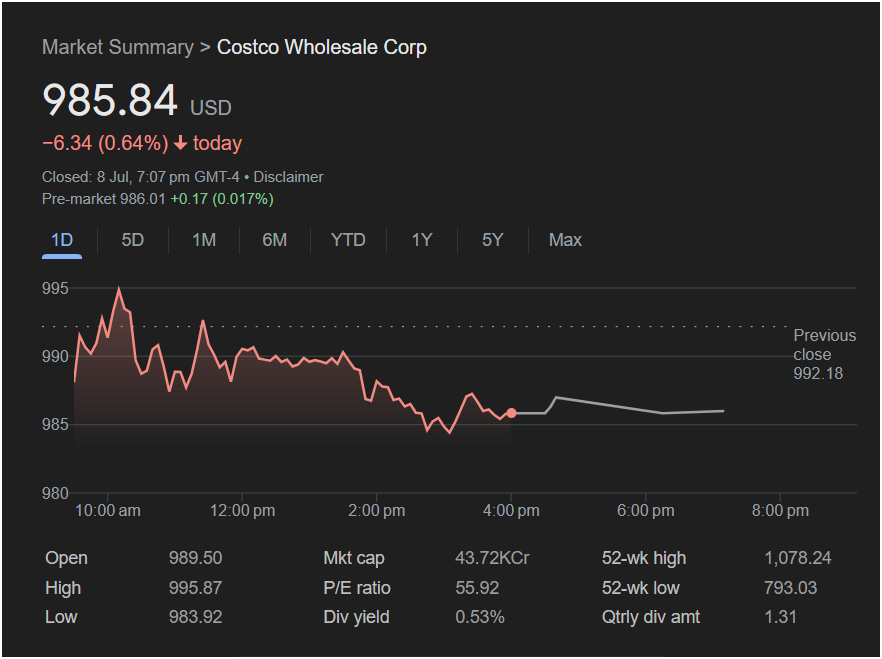The $1,000 Question: Inside Costco’s Volatile Trading Day and the High-Stakes Battle Over Its Stratospheric Valuation

Issaquah, WA – In the sprawling landscape of American retail, Costco Wholesale Corp. (COST) stands as a unique and beloved titan. It is a cathedral of commerce, a warehouse wonderland where shoppers can buy a lifetime supply of paper towels, a diamond ring, and a legendary $1.50 hot dog all under one roof. Its business model is the gold standard of customer loyalty, a fortress built on the bedrock of membership fees and bulk-bargain bliss. For decades, this operational excellence has translated into spectacular returns for its shareholders, making it one of the most revered stocks on Wall Street.
But on a recent trading day, the seemingly impenetrable fortress showed a flicker of vulnerability. The stock closed at
6.34 in a single session, a loss of 0.64%. While not a cataclysmic plunge, the decline was significant enough to raise eyebrows and stir a debate that has been simmering beneath the surface of the stock’s relentless ascent. The intraday chart reveals a story far more dramatic than the modest closing loss suggests: a day of wild swings, featuring a powerful morning rally that was brutally rejected, followed by a slow, grinding decline into the closing bell.
This was not just a routine day of profit-taking. It was a skirmish in a much larger war, a high-stakes conflict over one of the most pressing questions in today’s market: Is Costco, the paragon of value for consumers, an overvalued liability for investors? The stock’s eye-watering Price-to-Earnings (P/E) ratio of 55.92—a valuation typically reserved for high-flying software companies, not brick-and-mortar retailers—was at the very heart of the day’s conflict. The trading session became a real-time referendum on whether Costco’s unparalleled business quality can justify a price tag that seems to defy financial gravity itself.
This in-depth analysis will venture deep inside the numbers and the narrative of this pivotal trading day. We will dissect the volatile price action, moment by moment, to understand the forces that drove it. We will explore the “Costco Paradox”—the stark contrast between its value-driven business and its growth-obsessed stock price. We will deconstruct every financial metric provided in the screenshot to illuminate the bull and bear cases that are locked in a ferocious struggle. Finally, we will assess the profound implications of this single day for Costco’s investors, the retail sector, and the broader market’s appetite for “quality at any price.”
Part I: The Anatomy of a Reversal – A Chronicle of the Day’s Intraday Drama
To truly grasp the significance of the 0.64% drop, one must look past the final number and immerse oneself in the turbulent narrative of the trading day. The stock chart is a polygraph test for market sentiment, and on this day, its needles were jumping wildly, telling a story of initial hope, sharp rejection, and weary surrender.
Act 1: The Bull Trap (Pre-Market and the Opening Surge)
The day began on an unsteady footing. The previous session had closed at a formidable
0.17 (0.017%) to
989.50. This “gap down” of nearly $3 was the first indication that sellers had the early advantage.
However, what happened next was a classic “bull trap.” Instead of continuing lower, a wave of enthusiastic buying immediately entered the market. Perhaps investors saw the initial dip as a fleeting buying opportunity in a long-term uptrend. Perhaps a minor, positive news item—stronger-than-expected international sales data or a favorable mention on a financial news network—was just enough to ignite the buying interest.
Whatever the catalyst, the result was a powerful rally in the first hour of trading. The stock charged higher, blowing past the previous day’s close and surging toward the psychologically significant
995.87** around 10:30 AM. For a brief period, it appeared as though the stock was shaking off the early weakness and was poised to challenge its all-time highs. The bulls were firmly in control, and the narrative of Costco’s unstoppable ascent seemed destined to continue for another day. This surge was a demonstration of the immense goodwill and momentum the stock has accumulated; it is a name that investors are conditioned to buy on any sign of weakness.
Act 2: The Brick Wall at $996 (10:30 AM – 12:30 PM)
At the peak of $995.87, the rally did not just fizzle out; it hit a brick wall and shattered. The reversal was swift and decisive, marking the day’s crucial inflection point. This is where the powerful, underlying debate about valuation came roaring to the forefront.
As the price approached the day’s high, a formidable wall of sellers emerged. These sellers can be broken down into several groups:
-
Profit-Takers: Costco’s stock has been on a phenomenal run, as evidenced by its 52-week low of $793.03. Investors who bought the stock months or even weeks ago were sitting on substantial gains. For them, a price near $1,000 was an irresistible opportunity to cash in some of their chips.
-
Valuation-Conscious Investors: This is the most critical group. Institutional portfolio managers, hedge funds, and sophisticated individual investors looked at the P/E ratio of 55.92 and concluded that the stock was fundamentally overvalued. They saw the morning rally not as a sign of strength, but as a bubble of irrational exuberance. They initiated large sell orders, believing the stock was priced for a level of perfection that even a company as brilliant as Costco could not possibly achieve.
-
Short-Sellers: Traders who bet on a stock’s decline would have identified Costco as a prime target due to its extended run and extreme valuation. The failure to decisively break through the $996 level was their signal to pounce, adding immense downward pressure.
The result was a sharp, volatile decline. The chart shows a series of jagged peaks and valleys as the stock tumbled from its high. This was the most intense period of conflict, a high-volume churn as the initial morning buyers were forced to capitulate and sell to the new, dominant force of sellers. The stock quickly gave back all of its morning gains, falling back below the previous day’s close and signaling a decisive shift in the day’s sentiment.
Act 3: The Grinding Descent (12:30 PM – 3:30 PM)
After the intense battle of the late morning, the afternoon was characterized by a slow, methodical bleed. The stock entered a clear downtrend, marked by a pattern of lower highs and lower lows. This was no longer a panicked sell-off but a steady, persistent erosion of price, which is often a more bearish sign. It indicates that the sellers were in firm control and were able to absorb any small buying attempts without difficulty.
During this period, broader market sentiment may have also played a role. If the S&P 500 or NASDAQ were also weakening throughout the day, it would have created an additional headwind for Costco, making any recovery effort nearly impossible. The stock drifted lower, breaking through the $990 support level, then $888, and then $886, with each break triggering more automated sell programs.
This grinding descent is demoralizing for the bulls. The hope from the morning rally was a distant memory, replaced by the grim reality that sellers were dictating the price at will. It was during the late afternoon that the stock carved out its low for the day: $983.92.
Act 4: The Weak Close and a Feeble Bounce (3:30 PM – 4:00 PM)
In the final minutes of trading, the stock managed a very slight bounce off its lows to close at $985.84. This was not a sign of renewed strength but more likely a result of some minor short-covering from traders closing out their profitable bearish bets before the end of the day.
The key takeaway is that the stock closed near its lows, a technically weak position that suggests the selling pressure could continue into the following session. The final print of down 0.64% completely masked the intraday drama: the failed rally, the brutal reversal, and the victory of the valuation-conscious bears. The nearly flat pre-market activity for the next day (+0.17) suggests a market holding its breath, with the bears still holding the psychological advantage after successfully defending the highs and pushing the stock lower.
Part II: The Costco Paradox – A Tale of Two Companies
To understand the ferocious battle that took place during this trading session, one must understand that investors are essentially looking at two different Costcos. There is Costco the Business—a masterpiece of operational efficiency and customer devotion. And then there is Costco the Stock—a high-octane growth vehicle trading at a valuation that seems utterly disconnected from the physical reality of its warehouses. The day’s volatility was a direct result of these two identities clashing.
The Bull Case: The Indomitable Fortress of Retail (The Business)
The argument for owning Costco stock, even at these elevated levels, is built upon the near-perfection of its business model. This is the story the morning buyers were telling themselves as they pushed the price toward $1,000.
-
The Membership Model: This is the secret sauce. Costco makes very thin margins on the products it sells—the Kirkland Signature items, the electronics, the pallets of water. Its primary source of profit is the annual membership fee. In 2023, this amounted to over $4.5 billion in high-margin, recurring, predictable revenue. This “annuity” stream gives the company immense financial stability and allows it to offer rock-bottom prices on its goods, which in turn drives member loyalty and renewal rates that consistently hover around 90%. It’s a virtuous cycle that is the envy of the retail world.
-
The Treasure Hunt Experience: A trip to Costco is more than just shopping; it’s an event. The constantly rotating inventory of high-end goods, from kayaks to designer handbags, creates a sense of discovery and urgency. This “treasure hunt” aspect drives frequent visits and higher average spending per trip, something that online-only retailers struggle to replicate.
-
Kirkland Signature: A Brand Unto Itself: Costco’s private label brand, Kirkland Signature, is a juggernaut. It is renowned for its quality, often being manufactured by the same companies that produce the leading national brands. It accounts for over a quarter of Costco’s total sales and is a massive driver of customer trust and value perception.
-
Unwavering Customer Loyalty: The combination of value, quality, and experience has cultivated one of the most loyal customer bases on the planet. Costco’s members are typically more affluent than the average retail shopper, making them more resilient during economic downturns. This demographic strength is a huge selling point for investors seeking stability.
-
International Growth Runway: While a dominant force in North America, Costco still has significant room to grow internationally. New store openings in countries like China, Sweden, and New Zealand have been met with overwhelming success, suggesting a long runway for future expansion and revenue growth.
The bulls who bought the stock at $995 believe that this unparalleled business quality deserves a permanent premium valuation. They argue that Costco is not just a retailer; it’s a blue-chip consumer staple with tech-like loyalty metrics, and therefore, traditional retail valuation metrics simply do not apply.
The Bear Case: The Stratospheric Heights of Valuation (The Stock)
The sellers who emerged in force at the day’s high were looking at a completely different story. They acknowledge the brilliance of the business but are terrified by the price of the stock. Their case is built on one number: P/E ratio of 55.92.
-
A Price That Demands Perfection: A P/E ratio of nearly 56 implies that investors are willing to pay almost $56 for every one dollar of Costco’s current annual earnings. To put this in perspective, Walmart (WMT), another retail giant, trades at a P/E of around 25-28. Target (TGT) trades around 15. Even a technology behemoth like Google (GOOGL) often trades at a P/E below 30. Costco’s valuation is more than double that of its closest peers and is deep in technology-stock territory.
-
The Law of Large Numbers: This valuation prices in an expectation of massive, uninterrupted future growth. However, Costco is already a colossal company with a market capitalization of roughly $525 billion (based on a conversion of the “43.72KCr” figure). The “law of large numbers” dictates that it becomes progressively harder for a company of this size to grow at the rapid pace required to justify such a high multiple. Can a company that relies on building giant physical warehouses truly grow as fast as a software company with infinitely scalable products? The bears say no.
-
Consumer Sensitivity: While Costco’s customer base is affluent, it is not immune to economic pressure. A significant recession could eventually lead to consumers cutting back on discretionary purchases, opting for cheaper alternatives, or even letting their memberships lapse. The current valuation leaves absolutely no room for any such slowdown.
-
Competitive Threats: While Costco’s moat is wide, it is not unbreachable. Amazon Prime offers a compelling value proposition with the convenience of home delivery. Walmart’s Sam’s Club is a direct competitor that has been improving its offerings. A P/E of 56 suggests a company with no credible threats, which is rarely the case in the hyper-competitive retail sector.
The sellers who drove the stock down from $995.87 to $983.92 were making a powerful statement: The business is an A+, but the stock price is an F for risk management. They believe a “reversion to the mean” is inevitable, and that the stock could fall 30-50% and still be considered fairly valued by historical retail standards.
Part III: Deconstructing the Dashboard – The Metrics of the Conflict
Every number on the market summary screenshot adds a layer of depth to this central conflict between business quality and stock valuation.
Market Capitalization (43.72KCr): The Weight of a Giant
As noted, this figure translates to a market value of over half a trillion dollars. This immense size is a double-edged sword. On one hand, it reflects the company’s incredible success and dominant market position. It is a member of the S&P 100, a mega-cap stock held in countless ETFs and mutual funds, giving it a stable institutional investor base. On the other hand, this size is what makes the growth expectations embedded in its P/E ratio so daunting. Doubling in size from a $10 billion company is far easier than doubling in size from a $500 billion company. The day’s reversal from the highs was a manifestation of the market’s anxiety about this very challenge.
Dividend Yield (0.53%) & Quarterly Dividend ($1.31): A Token Gesture
Like Apple, Costco has a very low dividend yield. The annual dividend of
1.31 x 4) provides a yield of just over half a percent. This signals to investors that Costco, despite its age and size, is still being managed and valued as a growth company. The vast majority of its capital is reinvested into the business (new stores, logistics, e-commerce) rather than being returned to shareholders as income.
This is a critical point. The low dividend yield means there is no “valuation floor” provided by income-seeking investors. A value investor looking for a 3% or 4% yield would not even consider Costco at this price. This means the stock’s support rests almost entirely on the conviction of growth investors. When that conviction wavers, as it did at 10:30 AM on this trading day, the stock can fall quickly because there is no cushion of value buyers to step in and absorb the selling pressure. (It’s worth noting Costco is famous for its occasional large “special dividends,” but these are unpredictable and not part of the regular yield calculation that provides support).
52-Week Range (High: $1,078.24, Low: $793.03): A Journey to the Stratosphere
The day’s closing price of $985.84 is much closer to the 52-week high than the low. This tells us the stock has had a phenomenal year, rewarding shareholders handsomely. This powerful uptrend is what created the bullish momentum seen in the morning rally.
However, it’s also what made the stock so vulnerable. A stock that has gone up so much, so fast, is naturally prone to profit-taking. Furthermore, the distance from the low shows just how much the valuation has expanded. The move from ~
1,000 has been driven by a rapid expansion of the P/E multiple, a sign of increasing speculative fervor. The day’s reversal can be seen as the market’s first serious attempt to put a ceiling on that expansion, suggesting that the “easy money” in Costco’s recent run may have already been made.
Part IV: The Ripple Effect – When Costco Slips, Who Feels the Tremor?
A down day for a bellwether like Costco sends ripples across the economic pond, affecting investors, competitors, and the market’s overall psyche.
For the Costco Investor: A Crisis of Faith?
The day’s events force Costco investors to ask themselves a fundamental question: “What kind of stock do I own?”
-
The Long-Term Believer: This investor, likely a Costco member themselves, bought the stock based on the business’s quality. They see the 0.64% drop as completely meaningless noise. Their thesis is measured in years, not hours. They trust in the membership model, the international growth, and the management team. For them, this was a non-event.
-
The Momentum Investor: This investor bought Costco because it was a “winner.” They were riding the powerful uptrend. For them, the day was alarming. The sharp reversal from the high and the weak close is a bearish technical signal that the momentum may be broken. They are now on high alert, watching to see if the stock breaks below the day’s low, which could signal a much deeper correction.
-
The Valuation-Aware Owner: This investor loves the company but has become increasingly nervous about the price. They may have been trimming their position on the way up. The day’s reversal validates their fears and likely encourages them to sell more of their shares, adding to the pressure.
For the Retail Sector: A Bellwether’s Whisper
Costco is a crucial barometer for the health of the upper-middle-class consumer. While a single down day is not a definitive signal, its weakness, especially if it continues, could be interpreted as a warning sign.
-
Are High-End Consumers Pulling Back? If even Costco’s resilient customer base is beginning to feel the effects of inflation or economic uncertainty, it could spell serious trouble for other premium retailers and brands that lack Costco’s value proposition.
-
The Flight to Value: A potential decline in Costco’s stock could trigger a rotation within the retail sector. Investors might sell high-P/E Costco and buy lower-P/E names like Target or even grocery chains like Kroger, betting that the market’s obsession with “quality at any price” is coming to an end.
-
Competitive Dynamics: A struggling Costco stock could embolden competitors. Sam’s Club (owned by Walmart) and BJ’s Wholesale Club would see it as an opportunity to highlight their own value and attempt to poach members.
Fictionalized Analyst Commentary: The Verdicts from the Street
In the wake of such a day, the analyst community would be abuzz with conflicting takes.
-
The Bull (e.g., an analyst at a blue-chip growth fund): “Today’s minor pullback should be viewed as a healthy consolidation within a powerful secular uptrend. The business fundamentals remain impeccable, with strong traffic, high renewal rates, and a significant international growth runway. The attempt to rally in the morning shows the deep underlying demand for the shares. We view any weakness as a long-term buying opportunity. The premium valuation is justified by its best-in-class business model and its fortress-like stability in an uncertain world.”
-
The Bear (e.g., a strategist at a value-focused hedge fund): “Today’s price action was a classic topping signal. The failure at the highs on significant volume, followed by a close near the lows, is a textbook bearish reversal. The market is finally waking up to the absurdity of a 56 P/E ratio on a brick-and-mortar retailer. This is not a consolidation; it is the beginning of a long-overdue correction that could see the stock fall to the
800 level to find a more rational valuation. We are advising clients to sell into any strength.”
-
The Neutral Technical Analyst: “The chart now presents a clear picture of conflict. The day’s high of $995.87 has been established as formidable overhead resistance. The day’s low of $983.92 is now the key short-term support level. The stock is in a precarious position. A break below $983 would confirm the bearish reversal and likely lead to a test of the $950 level. To negate the bearish implications of today’s action, the bulls need to push the price back above $996 with conviction. Until then, caution is warranted.”
A Crack in the Polished Concrete Floor
The final closing price of $985.84 for Costco Wholesale Corp. was a deceptively quiet end to a tumultuous day. It was a day that laid bare the central, defining paradox of this extraordinary company: the chasm between its undeniable operational genius and its breathtakingly expensive stock price. The battle that raged between the day’s high and low was a proxy war for the soul of the market itself—a fight between the believers in quality at any price and the disciples of fundamental value.
The day’s events did not provide a final answer. The bulls demonstrated their power by driving the stock up aggressively in the morning, showing the deep well of investor support. The bears, however, won the day, successfully arguing through their sell orders that there is, in fact, a limit to what the market will pay, even for a company as magnificent as Costco. The rejection from the highs was a potent reminder that the laws of financial gravity, while they can be suspended for long periods, are never truly repealed.
This single trading day, encapsulated in one screenshot, serves as a crucial data point in Costco’s ongoing story. It was a warning shot, a sign that the flawless ascent into the four-figure territory will be a hard-fought battle. For investors, it was a test of conviction. For the market, it was a moment of reckoning with one of its most beloved, and most expensive, darlings. The question of whether Costco can continue to defy valuation norms remains unanswered, but after this day of conflict, the bears have drawn a clear line in the sand. And the entire world of investing is watching to see if it will hold.






